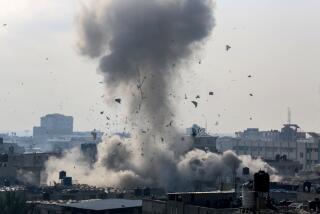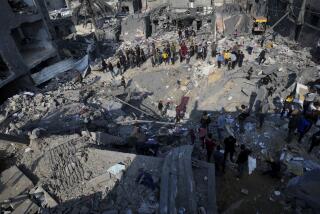Iraq Begins Destruction of U.N.-Banned Arms
BAGHDAD — Iraq used bulldozers to crush four of its Al-Samoud 2 missiles Saturday, meeting the U.N.’s deadline to begin eliminating the medium-range rocket from its arsenal. In other signals of heightened cooperation, it also destroyed a casting chamber for solid-fuel rockets and offered up more scientists for private interviews with weapons inspectors.
The steps seemed aimed at getting a positive report this week from chief U.N. weapons inspector Hans Blix to help avert the threat of war. Blix is to offer his latest assessment of Iraqi compliance with U.N. demands at a Security Council meeting Friday.
Destruction of the Al-Samoud 2 missiles began at the sprawling Taji military complex, 20 miles north of Baghdad, where they had been brought from the army positions where they had been deployed. Their destruction was watched by U.N. inspectors and took several hours, in part because the first bulldozer brought in by the Iraqis was not heavy enough to crush the missiles’ steel casings.
“They built it very strong,” said Blix’s deputy, Demetrius Perricos, who was in Baghdad to coordinate with Iraqi officials on the methods and pace for destroying the liquid-fuel rockets that have the potential to carry chemical and biological warheads as well as conventional ones.
Perricos said the Iraqis decided that the missiles should be crushed, although he would have preferred blowing them up because it would be faster. He refused to speculate about how the Iraqi actions might play at the United Nations.
“Taking the Samoud 2 system out of the way is definitely a concrete action on disarmament,” Perricos said, but added: “I cannot tell you if this development pushes the war away.”
Blix declared Feb. 21 that the missile was proscribed and must be destroyed after an international panel of rocket experts concluded that the weapon had the potential to exceed a U.N.-mandated limit of 93 miles.
Perricos said that the U.N. set no specific deadline for the destruction of all 100 to 120 missiles, their engines and components, as well as related software, documentation and designs. He said, however, that it could be possible to complete the destruction in two weeks if Iraq makes the commitment.
Meanwhile, Hiro Ueki, spokesman for U.N. weapons inspectors in Baghdad, confirmed that two scientists were interviewed by inspectors Friday night without government “minders” present and without tape recorders.
U.S. officials, however, seemed unimpressed with either the interviews or the destruction of the missiles.
“U.N. Resolution 1441 called for a complete, total and immediate disarmament,” a White House spokeswoman said. “It did not call for pieces of disarmament.” In his weekly radio address Saturday, President Bush made no reference to Iraq’s moves and again called for President Saddam Hussein’s ouster.
“The safety of the American people depends on ending this threat,” Bush said.
He also vowed to rebuild Iraq with humanitarian aid and withdraw U.S. troops after a democratic government is in place.
*
Times staff writer Edmund Sanders in Washington contributed to this report.
More to Read
Sign up for Essential California
The most important California stories and recommendations in your inbox every morning.
You may occasionally receive promotional content from the Los Angeles Times.










